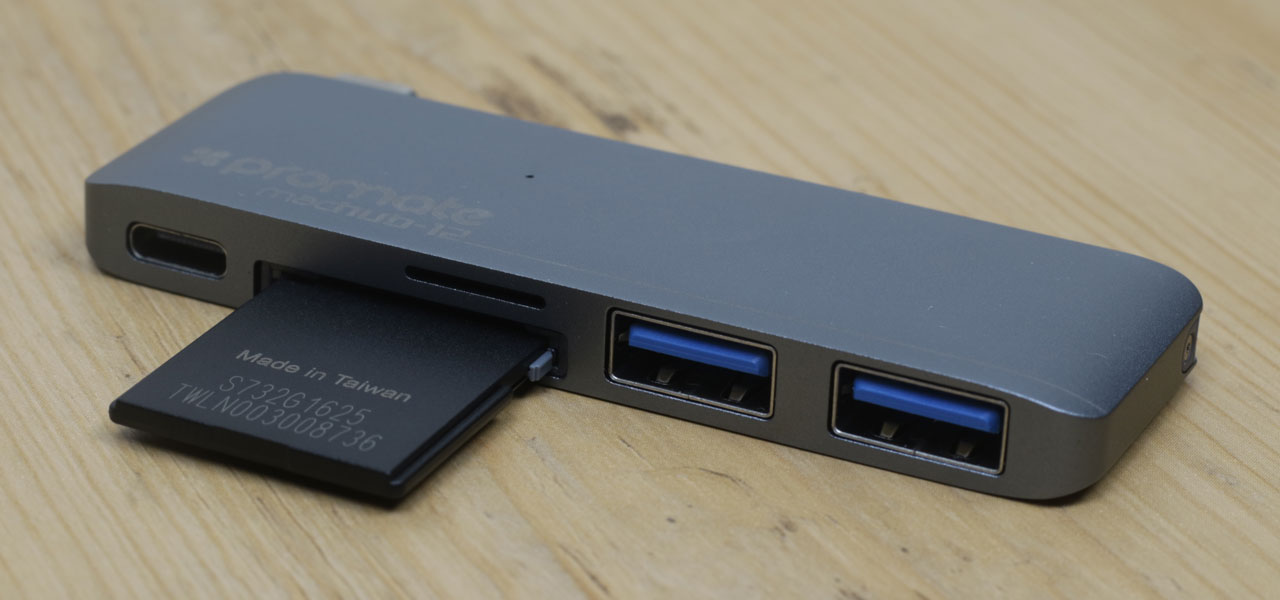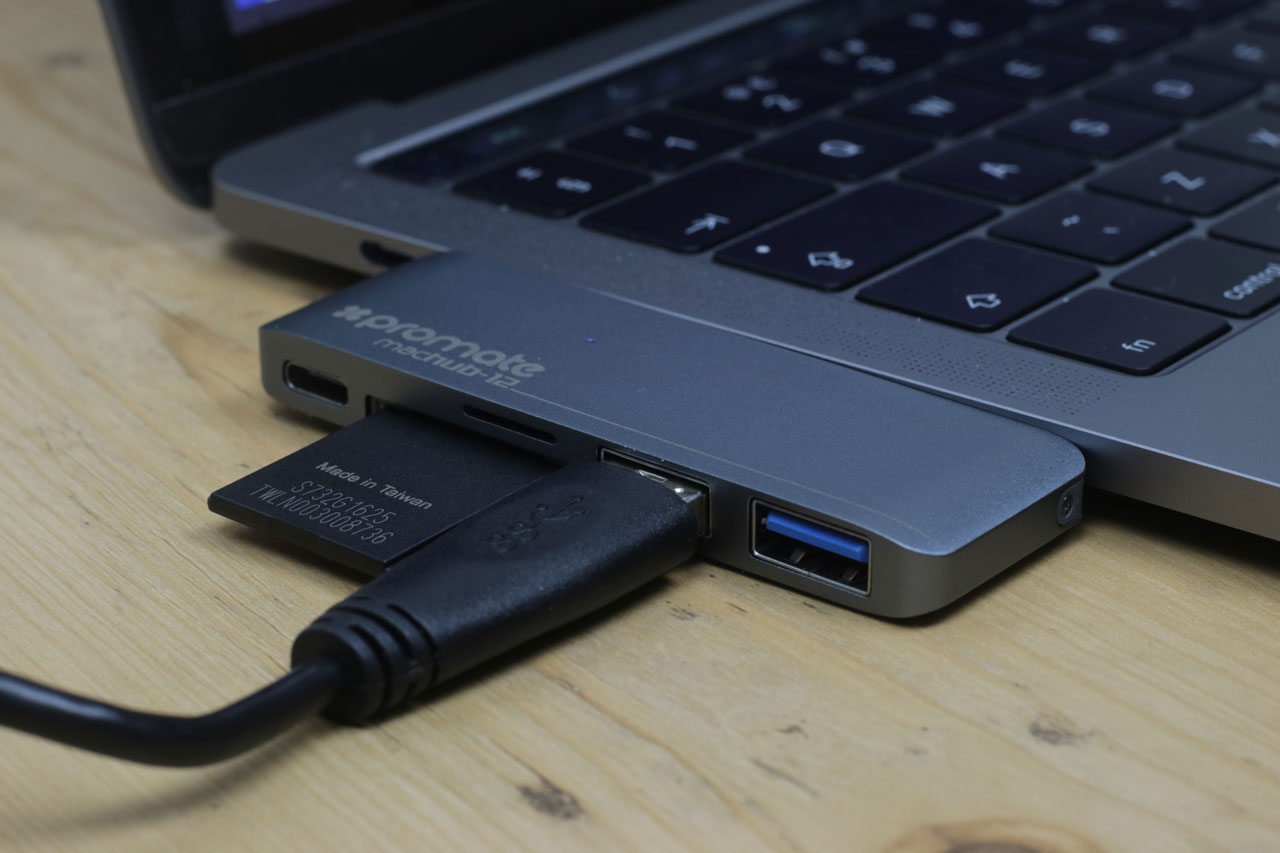Promate MacHub-12 USB-C to USB3, SD, microSD Adapter
Welcome to 2017. And happy new year!
Whether you like it or not, 2017 is the year of USB-C. With Apple pulling no punches when it comes to the controversial new port, and other manufacturers either including them in their devices already, or starting to add them, it’s clear the transition has begun.
I’m not going to lie. It’s going to be painful. USB-C is nothing if not outright confusing, and even I don’t fully understand its capabilities, its limitations and how they apply to various devices. One thing is clear, however; this tiny little port offers a heck of a lot of connectivity.
I’ll be hunting for many more USB-C goodies to write about this year, but the honour of being first goes to the Promote MacHub-12 which MobileFun were kind enough to send me for testing.

Designed for the MacBook, with its solitary USB-C port, the MacHub brings back a few of the lost ports that long-time Mac users will be mourning. It includes two USB3 ports, rightfully coloured blue, a microSD card slot, and an SD card slot. The 5th feature to complete it’s 5-in-1 set is the USB-C connector. The pass-through connector means it can be used with the MacBook and still let you charge.
If you juggle a lot of SD and microSD cards you’ll be pleased to know that the two slots are discrete- you can use one, or both at the same time for copying data across from one card to the other, or imaging multiple cards at once (if you’re a heavy Pi user ;). OSX “System Report” reports that both of these readers are internally connected to a USB3.0 hub, so they should be fast as heck. My naive testing confirms this suspicion. The only gripe I have against the SD card reader is that the card sticks out quite far when in use. Cards sticking right out of readers definitely isn’t unusual, but in this case more than 3/4 of the card is flapping in the breeze, versus less than one half in my old MacBook Pro’s internal SD card slot. To its credit, this means it doesn’t flip the lock switch on my SD cards, which is a problem I somehow managed to have frequently with the MacBook Pro. With the MacHub-12 being almost as wide as an SD card is long, I expected them to sit a bit more comfortably. microSD fares better, with only one third sticking out.
The USB-C connector, however, is power only. Set aside your dreams of daisy-chaining a monitor, mouse, keyboard, kettle, toaster from the MacHub-12. That USB-C port is for charging only.
Also counting against the MacHub-12 is the upstream USB-C connector. Since it’s moulded directly into the device, and not at the end of a short lead, it doesn’t work well with hard-shell cases, and also makes the MacHub-12 a really big lever against your MacBook’s USB-C port. If you’re careful, it’ll be fine, but it feels a little scary to use and you really need to hold it tight when plugging in, or removing, a USB device.
Power is an issue, too. I tested the MacHub-12 with the new TouchBar MacBook Pro and before bothering to read the specifications (of the MacBook Pro that is) I hooked up two external hard disk drives. They both spun up, drew waaay too much current and promptly shut down. I spent the next half hour running disk repair operations. D’oh. From what I can tell, the MacBook Pro’s USB-C ports can deliver up to 2A which isn’t quite enough for *two* spinning rust disk drives. Don’t try this at home. Using anything other than power-hungry hard disk drives should serve you well.
In my testing I used the MacHub-12 for a simple operation that I knew it’d be used for on a regular basis; copying files from an SD card over to a USB hard disk. As a photographer, this is an operation I perform frequently, and as the WiFi feature in my camera (the EOS-M3) for some completely insane reason only works with smartphones and tablets (why, WHY!?) I’m forced to use some sort of memory card reader. Incidentally my Retina MacBook Pro has had a broken SD card reader for a few months now, so I’m used to adaptors 😉
Copying photos was lightning quick, and an 870mb video file whisked from the SD card over to the HDD in about 5 seconds. Extrapolating this out with rigorous maths (ha ha, mostly guesswork) means I could probably dump a full 32GB card in about 3 minutes. This is probably more a score for USB3.0 than USB-C, but as I’ve been using USB2 and a really ancient (seriously, I reviewed it back in 2008) card reader for years now, it’s a night-and-day upgrade.

Aesthetically the MacHub-12 mirrors the MacBook and MacBook Pro. It’s manufactured from aluminium and is weighty and solidly built. The back is plastic, but it’s inserted into the metal body and screwed into place. The USB-C connector is definitely going to be the first part to wear out. It’s available in Silver, Gold and Space Grey to match your choice of MacBook and, of course, works with Windows computers that sport USB-C ports too (I tested it with the Razer Blade).
As I mentioned before, the moulded USB-C connector is definitely a con. It makes the long MacHub-12 a potentially dangerous lever against your USB-C port. I think a design like the Kanex 3-Port Card Reader is much safer, but if you’re careful then it makes for a really visually appealing accessory and could work quite well to, for example, dock a hard disk, memory card reader and mouse when you switch to a desktop.
On the pro side, however, is that the SD and microSD card readers are not mutually exclusive. You can read/write to both at the same time. This may, perhaps, be due to the USB3 hub internal to the design of the MacHub- meaning each card reader has its own chip, internally connected to a USB “port”. This is a huge plus, since some simpler card readers I’ve tested have only been capable of reading a single card at once.
Overall I’m thrilled with the MacHub-12, and despite my concerns will keep using. I’ll let you know if I find a better alternative. It’s £34.99 and you can pick it up from MobileFun.